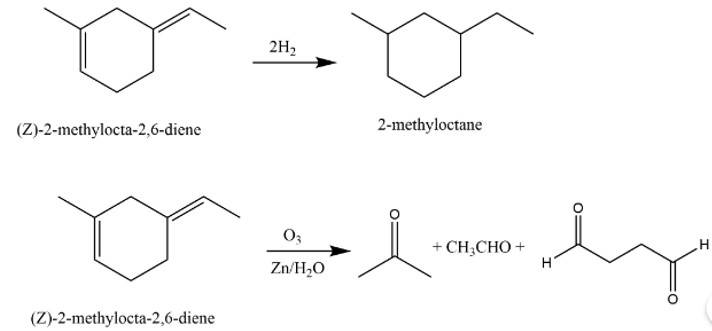Class 11th
Get insights from 8k questions on Class 11th, answered by students, alumni, and experts. You may also ask and answer any question you like about Class 11th
Follow Ask QuestionQuestions
Discussions
Active Users
Followers
New answer posted
5 months agoContributor-Level 10
(a) Frequency of emission, ν = c/λ = (3.0 x 108 ms-1) / (616 x 10-9 m) = 4.87 x 1014 s-1
(b) Speed of radiation, c = 3 x 108 ms-1
Distance travelled by this radiation in 30s = 3 x 108 ms-1 x 30 s = 9.0 x 109 m
(c) Energy of quantum, E = hν =hc/λ = [ (6.626 x 10-34Js) x (3 x 108 ms-1)] / (616 x 10-9 m) = 32.27 x 10-20 J
(d) Number of quanta present if it produces 2 J of energy
&n
New answer posted
5 months agoContributor-Level 10
This is a short answer type question as classified in NCERT Exemplar
If arenes would undergo electrophilic addition reaction then they would lose their aromaticity which would lead to comparatively less stability. However, alkenes undergo electrophilic addition reaction via carbocation intermediate.
New answer posted
5 months agoContributor-Level 10
Power of the laser E = Nhv = Nh c/λ, where N is the number of photos emitted
= [ (5.6 x 1024) x (6.626 x 10-34Js) x (3 x 108 ms-1)] / (337.1 x 10-9 m)
= 3.3 x 106 J
New answer posted
5 months agoContributor-Level 10
The given radiations in increasing order of wavelength are:
Cosmic rays < X-rays < radiation from microwave oven < amber light from traffic signal < radiation from FM radio
New answer posted
5 months agoContributor-Level 10
This is a long answer type question as classified in NCERT Exemplar
The bond energy of HCl is higher than that of HBr thus it is not cleaved by free radical mechanism to exhibit peroxide effect. However in case of HI the bond energy is so low that the iodine radical forms readily and after formation it combines to form an iodine molecule.
New answer posted
5 months agoContributor-Level 10
Let the no. of electrons in the ion= x
∴ the no. of the protons= x + 3 (as the ion has three units positive charge)
and the no. of neutrons= x + (x*30.4 / 100) = x+ 0.304 x
Now, mass no. of ion = No. of protons + No. of neutrons = (x + 3) + (x + 0.304x)
∴ 56 = (x + 3) + (x + 0.304x)
=>2.304x = 56 – 3 = 53
=>x = 53 / 2.304 = 23
Atomic no. of the ion (or element) = 23 + 3 = 26
The element with atomic number 26 is iron (Fe) and the corresponding ion is Fe3+.
New answer posted
5 months agoContributor-Level 10
Let the no. of electron in the ion = x
∴ The no. of protons = x – 1 (as the ion has one unit negative charge)
and the no. of neutrons = x + (x*11.1 / 100) = 1.111 x
Mass of the ion = No. of protons + No. of neutrons
(x – 1) + (1.111 x)
Given mass of the ion = 37
∴ (x – 1) + (1.111 x) = 37
=> 2.111 x = 37 + 1 = 38
x = 38 / 2.111 = 18
No. of electrons = 18; No. of protons = 18 – 1 = 17
Atomic no. of the ion = 17; atom corresponding to ion = Cl
Symbol of the ion = 3717Cl–
New answer posted
5 months agoContributor-Level 10
This is a long answer type question as classified in NCERT Exemplar
The structure of A is
The reaction involved are as follows:

New answer posted
5 months agoContributor-Level 10
An element can be identified by its atomic number only. Let us find the atomic number.
Let the number of protons = x
Number of neutrons = x + (x*31.7/100) = 1.371x
Now, Mass no. of element = no. of protons + no. neutrons
⇒ x + 1.317x = 81
⇒ x = 34.958
x ? 35
∴ No. of protons = 35, No. of neutrons = 81 – 35 =46
Atomic number of element (Z) = No. of protons = 35
The element with atomic number (Z) 35 is bromine (3579Br)
New answer posted
5 months agoContributor-Level 10
The composition of any atom can be represented by using the normal element symbol (X) with super-script on the left hand side as the atomic mass number (A) and subscript (Z) on the left hand side as the atomic number (i.e., AZX).
No two elements can have the same atomic number. However, the mass numbers have to be mentioned in order to identify the elements. Thus, symbols 7935Br and 79Br are accepted because atomic number of Br will remain 35 even if not mentioned.
For a given element, the number of protons is the same for the isotopes, whereas the mass number can be different for the given atomic number. Hence, correct pl
Taking an Exam? Selecting a College?
Get authentic answers from experts, students and alumni that you won't find anywhere else
Sign Up on ShikshaOn Shiksha, get access to
- 65k Colleges
- 1.2k Exams
- 679k Reviews
- 1800k Answers
